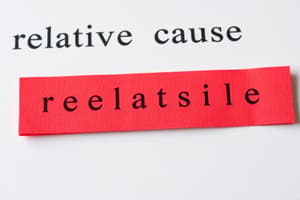Podcast
Questions and Answers
Which relative pronoun is used to add information about a noun that represents a person and acts as the subject of the relative clause?
Which relative pronoun is used to add information about a noun that represents a person and acts as the subject of the relative clause?
- Which
- Whose
- Whom
- Who (correct)
In which situation would you use the relative pronoun 'whom'?
In which situation would you use the relative pronoun 'whom'?
- To refer to a place.
- To refer to a possessive relationship.
- To refer to an object.
- To refer to a person as the object of a verb or preposition. (correct)
The relative pronoun 'which' is used to introduce a relative clause that modifies what type of noun?
The relative pronoun 'which' is used to introduce a relative clause that modifies what type of noun?
- A person
- A place
- A thing (correct)
- A time
Under what condition is it generally correct to use 'that' as a relative pronoun instead of 'who,' 'whom,' or 'which'?
Under what condition is it generally correct to use 'that' as a relative pronoun instead of 'who,' 'whom,' or 'which'?
In which type of relative clause is the use of 'that' generally avoided?
In which type of relative clause is the use of 'that' generally avoided?
Which relative pronoun should be used after a preposition?
Which relative pronoun should be used after a preposition?
After a superlative adjective, which relative pronoun is most appropriate?
After a superlative adjective, which relative pronoun is most appropriate?
In sentences that begin with 'This/It is the...' followed by an ordinal number (first, second, etc.) and 'time,' which relative pronoun is required?
In sentences that begin with 'This/It is the...' followed by an ordinal number (first, second, etc.) and 'time,' which relative pronoun is required?
When using a cleft sentence (emphasizing a specific part of the sentence), which relative pronoun is used to introduce the clause providing additional information?
When using a cleft sentence (emphasizing a specific part of the sentence), which relative pronoun is used to introduce the clause providing additional information?
Which relative pronoun indicates possession?
Which relative pronoun indicates possession?
Which relative pronouns can be replaced by 'in which,' 'on which,' or 'at which'?
Which relative pronouns can be replaced by 'in which,' 'on which,' or 'at which'?
What function do 'where' and 'when' serve as relative pronouns?
What function do 'where' and 'when' serve as relative pronouns?
Identify the relative pronoun that best completes the sentence: 'My neighbor, ______ car is always blocking my driveway, is very inconsiderate.'
Identify the relative pronoun that best completes the sentence: 'My neighbor, ______ car is always blocking my driveway, is very inconsiderate.'
Choose the correct relative pronoun: 'The restaurant ______ I had dinner last night was excellent.'
Choose the correct relative pronoun: 'The restaurant ______ I had dinner last night was excellent.'
Select the appropriate relative pronoun to fill in the blank: 'The author ______ book won the Pulitzer Prize will be speaking at our university.'
Select the appropriate relative pronoun to fill in the blank: 'The author ______ book won the Pulitzer Prize will be speaking at our university.'
Which relative pronoun correctly completes this sentence: 'She is the journalist ______ interviewed the president yesterday.'
Which relative pronoun correctly completes this sentence: 'She is the journalist ______ interviewed the president yesterday.'
Determine the correct relative pronoun: 'The reason ______ he was late is still unknown.'
Determine the correct relative pronoun: 'The reason ______ he was late is still unknown.'
Choose the best relative pronoun for the following sentence: 'The package, ______ arrived this morning, contained the documents I needed.'
Choose the best relative pronoun for the following sentence: 'The package, ______ arrived this morning, contained the documents I needed.'
Identify the correct relative pronoun: 'That’s the student about ______ I was telling you yesterday.'
Identify the correct relative pronoun: 'That’s the student about ______ I was telling you yesterday.'
Select the right relative pronoun: 'The day ______ I graduated from college was one of the happiest in my life.'
Select the right relative pronoun: 'The day ______ I graduated from college was one of the happiest in my life.'
Choose the correct relative pronoun to complete the following sentence: 'The movie ______ we watched last night was based on a true story.'
Choose the correct relative pronoun to complete the following sentence: 'The movie ______ we watched last night was based on a true story.'
Choose the correctly combined sentence using a relative pronoun: 'I spoke to a man. His car had broken down.'
Choose the correctly combined sentence using a relative pronoun: 'I spoke to a man. His car had broken down.'
Combine the following sentences using a relative pronoun: 'The book is on the table. I need it.'
Combine the following sentences using a relative pronoun: 'The book is on the table. I need it.'
Combine the following two sentences using a relative pronoun: 'This is the town. I grew up here.'
Combine the following two sentences using a relative pronoun: 'This is the town. I grew up here.'
Use a relative pronoun to combine these sentences: 'I met a woman. She is a doctor.'
Use a relative pronoun to combine these sentences: 'I met a woman. She is a doctor.'
Choose the best sentence that combines the following using a relative pronoun: 'I bought a car. It is very expensive.'
Choose the best sentence that combines the following using a relative pronoun: 'I bought a car. It is very expensive.'
Which relative pronoun should be used to combine the sentences: 'She’s the teacher. I told you about her.'
Which relative pronoun should be used to combine the sentences: 'She’s the teacher. I told you about her.'
Select the combined sentence using a relative pronoun that best fits: 'That is the house. We lived there for five years.'
Select the combined sentence using a relative pronoun that best fits: 'That is the house. We lived there for five years.'
Choose the appropriate relative pronoun to use in combining the following sentences: 'That's the man. I saw him yesterday.'
Choose the appropriate relative pronoun to use in combining the following sentences: 'That's the man. I saw him yesterday.'
Combine the following sentences using the most suitable relative pronoun: 'I visited the museum. My father recommended it.'
Combine the following sentences using the most suitable relative pronoun: 'I visited the museum. My father recommended it.'
She is the woman ______ helped me.
She is the woman ______ helped me.
This is the book ______ I was telling you about.
This is the book ______ I was telling you about.
That's the restaurant ______ we ate last night.
That's the restaurant ______ we ate last night.
He is the man ______ car was stolen.
He is the man ______ car was stolen.
That was the year ______ they won the championship.
That was the year ______ they won the championship.
The teacher ______ I admire the most is retiring.
The teacher ______ I admire the most is retiring.
The movie, ______ was directed by Spielberg, was a box office hit.
The movie, ______ was directed by Spielberg, was a box office hit.
Flashcards
Relative Pronouns
Relative Pronouns
Relative pronouns introduce relative clauses, adding information to nouns.
WHO
WHO
"Who" refers to people and acts as the subject in the relative clause.
WHOM
WHOM
"Whom" refers to people and acts as the object in the relative clause.
WHICH
WHICH
Signup and view all the flashcards
THAT
THAT
Signup and view all the flashcards
WHOSE
WHOSE
Signup and view all the flashcards
WHERE
WHERE
Signup and view all the flashcards
WHEN
WHEN
Signup and view all the flashcards
Omission of THAT
Omission of THAT
Signup and view all the flashcards
"THAT" after Prepositions
"THAT" after Prepositions
Signup and view all the flashcards
"THAT" with Superlatives
"THAT" with Superlatives
Signup and view all the flashcards
"THAT" in Introductory Phrases
"THAT" in Introductory Phrases
Signup and view all the flashcards
Study Notes
Definition of Relative Pronouns
- Relative pronouns introduce relative clauses, adding information to a noun or noun phrase.
- They follow a noun or pronoun (him, her, you, them, it).
- Common relative pronouns include WHO, WHOM, WHOSE, WHICH, THAT, WHERE, WHEN and WHY.
- "My father whom you met yesterday is a doctor" is an example of relative pronouns.
- "This is the man who sat next to me yesterday" provides another example.
WHO
- WHO gives more detail about a noun that refers to a human
- WHO is used as the subject of the relative clause.
- The structure is: N (person) + WHO + Verb.
- Example: My uncle who has returned from Ho Chi Minh City is a teacher.
- Another Example: I don’t know the girl who is dancing on the stage.
WHOM
- WHOM gives more detail about a noun that refers to a human
- WHOM is used as the object of the relative clause.
- The structure is: N (person) + WHOM + Subject + Verb.
- Example: This is the girl whom you met at my party last week.
- Another Example: Henry is the boy whom I phoned yesterday.
- WHO can be used instead of WHOM: This is the girl who met you at my party last week.
- WHO can be used instead of WHOM: Henry is the boy who phoned me yesterday.
WHICH
- WHICH gives more detail about a noun that refers to a thing.
- WHICH functions as either the subject or the object of the relative clause
- The structure is: N (thing) + WHICH + (Subject + Verb) or (Verb + Object).
- Example: This is the table which my mother bought yesterday.
- Example: I like the dress which you are wearing.
- Example: The window which was broken in the storm has been repaired.
THAT
- THAT gives more detail about a noun phrase referring to people or things
- THAT can function as either the subject or the object of the relative clause.
- In regular sentences, it can replace WHO, WHOM, and WHICH.
- Example: I like the mountain which/that we climbed last week.
- Example: I can’t remember the name of the man whom/that I saw yesterday at your party.
- Example: Henry is the boy who/that phoned me yesterday.
Exceptions for THAT
- THAT is not used in non-restrictive relative clauses (those set off by commas).
- Example: Mary, whom you met yesterday at my house, is a famous singer.
- Example: I failed my exam, which made my Mom sad.
- THAT is not used after a preposition; instead, preposition + WHICH is used for things, and preposition + WHOM is used for people.
- Example: I don’t know the girl about whom you are talking.
- Example: I don’t know the girl whom/that you are talking about.
- Example: They have moved the table on which I put my keys.
- Example: They have moved the table which/that I put my keys on.
- THAT must be used after a superlative.
- Example: He is the most intelligent man that I have worked with.
- Example: The man whom/that I worked with in ABC cooperation was the most intelligent.
- Example: It is the longest bench that we have in the store.
- Example: The bench which/that we have in the store is the longest.
- THAT must be used in introductory sentence structures.
- This/It + is + the + ordinal number + time + THAT + S + have/has + V3...
- This/It + was + the + ordinal number + time + THAT + S + had + V3...
- Example: This is the 1st time that I have ever been to Hanoi.
- Example: It was the second time that John had phoned me.
- THAT is required in cleft/emphatic sentence structures.
- It + is/was + phrase (person, thing, place, time) + that + (S2 + V2 …) / (V2 + O2 …)
- It + is/was + phrase referring to a person + that / who + Verb + O ….
- Example: It was in this shop that I bought my new laptop.
- Example: It is my mother that I often share my secret with.
- Example: It is my mother that/who often shares her secret with me.
WHOSE
- WHOSE gives more detail about a noun that refers to nouns of possession.
- WHOSE functions as a possessive adjective.
- The structure is: N (person) + WHOSE + Noun + (S + Verb) / (Verb).
- Example: This is the man whose son is my classmate.
- Example: I couldn’t contact with the woman whose car was parking behind mine.
WHERE / WHEN
- WHERE / WHEN can equal (= IN/ ON/ AT … + WHICH).
- WHERE / WHEN function as adverbs of the relative clause.
- WHERE gives more detail about a noun phrase that refers to a place.
- WHEN gives more detail about a noun phrase that refers to time.
- The structure is: N (time/place) + when/where + Subject + Verb + …
- Example: This is the place where I met my wife.
- This is the place in which I met my wife.
- This is the place which I met my wife in.
- Example: I’ll see you near the post office where we met the other day.
- I’ll see you near the post office at which we met the other day.
- Example: I was born in 1975 when Viet Nam got the independence
- I was born in 1975 in which Viet Nam got the independence
Steps to Combine Sentences Using Relative Pronouns
- Step 1: Identify the noun/phrase that refers to the same person/thing in both clauses.
- Example: They are my students. They have got the scholarship.
- Example: I like the dress. You are wearing it.
- Example: Mr. John is a singer. He lives next to my house.
- Step 2: Choose one clause to be the main clause; the remaining clause becomes the relative clause.
- Step 3: In the relative clause, replace the noun/phrase (identified in step 1) with the appropriate relative pronoun.
- Example: They are my students. They have got the scholarship = WHO have got the scholarship.
- Example: I like the dress. You are wearing it = WHICH you are wearing WHICH.
- Example: Mr. John is a singer. He lives next to my house = WHO lives next to my house.
- Step 4: Move the relative pronoun to the beginning of the relative clause (if it is not already there).
- Step 5: Move the relative clause after the noun/phrase (identified in step 1) in the main clause (if necessary).
- Example: Mr. John, who lives next to my house, is a singer.
- Example: The new painting which my father bought was painted by Paul.
Studying That Suits You
Use AI to generate personalized quizzes and flashcards to suit your learning preferences.




